How Thick Should Stucco Be, The Code and Why it Matters
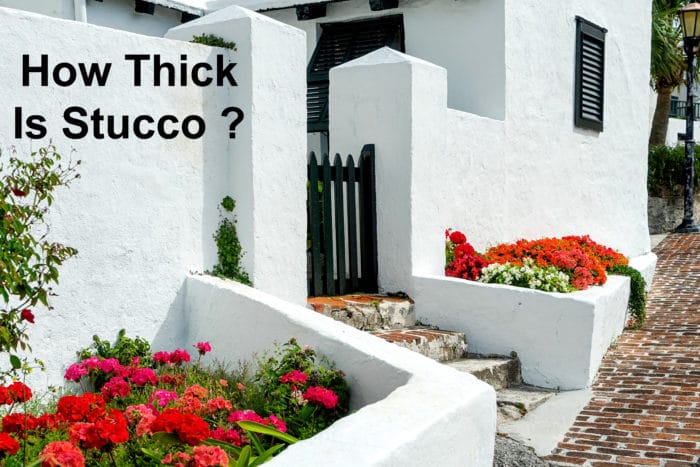
How thick is stucco? The thickness of stucco can affect its strength, the structural integrity of a building, cracking, its resistance to damage and weather, as well as its performance in earthquakes and fires.
Two key factors that determine the thickness of stucco:
- The type of stucco
- EFIS synthetic stucco
- Traditional Hard Coat stucco
- One Coat stucco
- What the stucco is applied over, i.e.
- Wood or metal framed walls
- Masonry concrete block surfaces
- Concrete poured in place surfaces
- Precast concrete surfaces
There is a third factor and that is workmanship. Did the workmen mixing and applying the stucco do it as good practices advise, per manufactures recommendations and per code requirements? Ask a contractor when the last time he saw anyone measuring the thickness of a stucco job; you may be surprised at the answer.
Codes. Note that the building codes have changed over the years and may vary from state to state and climate zone to climate zone. Therefore, the information provided in this article is an overall basic view and may not be fully applicable to your particular home, state or climate zone, but it will help you get a better understanding of how important the thickness of stucco is. Checking with your local building department will provide what their requirements are.
EFIS Synthetic Stucco is only 1/16 inch thick
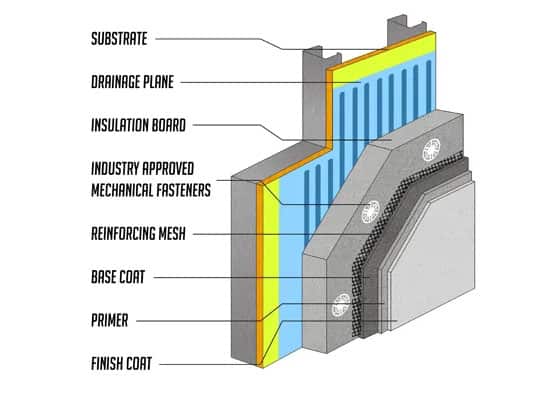
You ask, how this can be. The answer is that an EFIS synthetic stucco wall is actually a wall assembly or system that looks like “Traditional” stucco. The term EFIS stands for “Exterior Insulation and Finish Systems” and the outer finish of this system, which looks just like stucco, is 1/16 inch thick with a glass fiber reinforcement mesh embedded in a base coat covered by a crack-resistance and decorative finish.
The thickness of an EFIS wall assembly with the foamboard insulation, a water barrier and possibly a drain plane will vary. For instance, the thickness of the foam board in a EFIS system is usually about 1 inch thick in most installations but it may be much thicker, because the engineer wanted a higher insulation R value for energy purposes. Building codes generally do not allow an EFIS system to be over 4 inches, and rarely do you see one that thick and if so, it will probably be on a commercial building, not a residential home. Generally, an EFIS system on a home will be approximately 1 inch to an 1 ½ inches thick, including the foam board.
Traditional Hard Coat stucco is 7/8 inch thick
One of the factors that can affect the strength of Traditional Hard Coat stucco is the thickness. The building code has a minimum requirement for the thickness of Traditional Hard Coat stucco, it is 7/8 of an inch.
Traditional Hard Coat stucco is the most common type of stucco cladding used in the United States, it is applied in 3 layers over metal lath:
- Scratch coat 3/8 inch
- Brown coat 3/8 inch
- Finish coat 1/8 inch
- Total thickness is 7/8 of an inch
“One Coat” Stucco Systems – The stucco is usually 3/8 inch to 1/2 inch thick
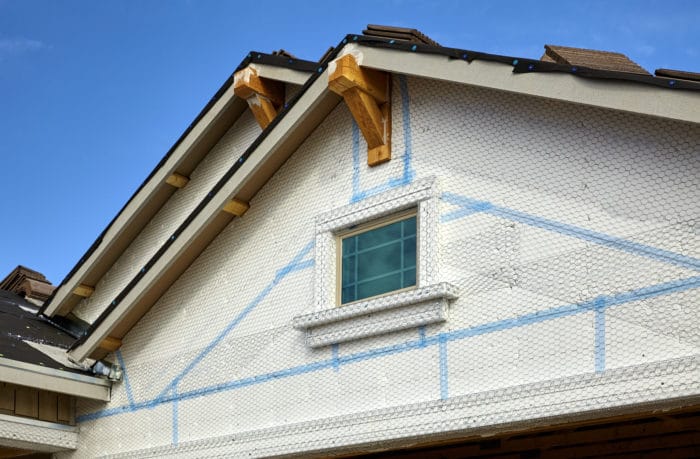
“One Coat” systems are proprietary layered systems with an engineered blend of cements and fibers applied over a “Styrofoam” type of rigid foam board with a metal wire lath. The “One Coat” systems will vary based on the manufactures design and installation requirements. To meet the building code, you generally cannot mix different manufactures requirements, you must install the system based on their specific installation and material guidelines.
Although it is called a “One Coat System,” the stucco material is usually a 3/8 inch thick coat with a 1/8 inch finish coat applied over it; thus two layers or coats.
Stucco Thickness Over Block / CMU Walls is ½ inch
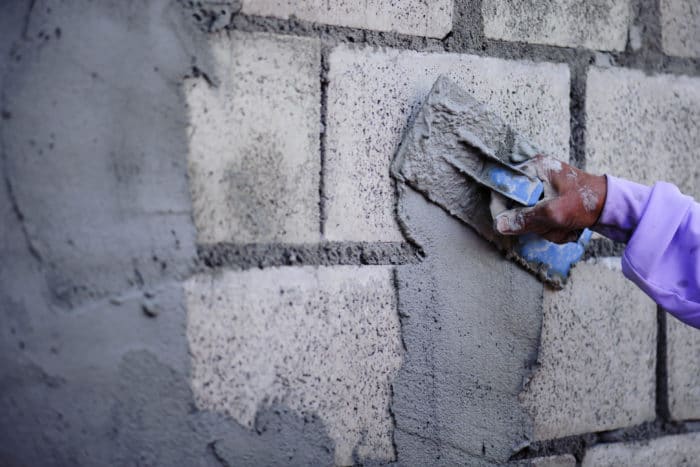
If your house or exposed basement wall is a masonry wall, sometimes referred to as concrete or cinder block, or CMU (concrete masonry unit) the thickness required is not 7/8 inch but is usually 1/2 inch; consisting of a 3/8 scratch coat and then a 1/8 inch finish coat over the scratch coat. Sometimes it may be 5/8 inch verses a 1/2 inch. If the stucco is applied too thick, there is a tendency for the stucco to crack and if it’s too thin, the mortar joints between the blocks may show through the stucco; thus, the wall loses part of its aesthetic look or appeal.
“CMU” Definition
CMU stands for Concrete Masonry Unit. They are often referred to as concrete blocks, cinder blocks or masonry blocks, depending on who you are speaking with. They come in various sizes and shape and the most common size is 8” x 8” x 16.”
Cast in place or poured in place concrete walls – stucco thickness 3/8 inch
These types of walls are usually constructed by using wood or metal forms with rebar placed in them and then concrete is poured into the form. After the concrete has cured and gained its strength, the forms are removed. Usually a two-coat stucco application is used on this type of wall and totals about 3/8 of an inch if no lath.
Precast concrete – stucco thickness usually about 3/8 inch
Precast concrete often has 3/8 inch stucco requirement or guideline, this is partially due to the fact that both cast in place and precast concrete provides a very good base to apply stucco over.
What stucco is applied over affects thickness
First, “Substrate” Definition
When builders and stucco contractors are discussing what the “substrate” is that the stucco is being applied over, they are generally referring to materials, such as, plywood or OSB board that is on a wood or metal stud framed wall. The substrate (i.e. plywood or OSB board” is what the building paper or wrap and / or the metal lath that the scratch coat of a traditional stucco installation goes over).
If stucco was being applied to a court yard block wall, then the substrate would be the block (CMU’s) themselves. If stucco was being applied directly onto a concrete poured in place wall or a precast wall, then the concrete wall itself would be the substrate.
Thickness of stucco matters, it’s important!
Stucco that is too thin or too thick may cause problems. It may influence:
- Strength of the stucco and the structural strength of the home
- Result in the cracking stucco
- Reduce fire resistance
- Create problems with lathing
- Affect the finish look of the wall
Thickness affects Strength
Studies indicate that on a Traditional Hard Coat stucco wall with lath, which should be 7/8 inch thick as required by code. That if it is 7/8 of an inch thick, it can withstand twice the impact as a wall where the stucco is only 1/2 or 5/8 inch thick. That 1/8 or 1/4 inch makes a tremendous difference. When a contractor is putting stucco on a wall that has plywood or an OSB substrate, he may feel he really does not need the full 7/8 inch of stucco, but the code does not lower the requirements of 7/8 inch because of the plywood or OSB substrate. You still need the full 7/8 inch thickness for Traditional “hard coat” stucco.
Structural
Traditional Hard Coat stucco walls not only help protect a house from moisture intrusion, but it helps provide additional shear resistance against storms and strong wind forces generated by hurricanes and tornadoes, as well as, adding additional shear protection in earthquakes.
Cracking issues
In cases where the stucco is too thin or too thick, cracking may occur. Cracked stucco allows moisture intrusion which then may lead to stucco deterioration or damage, especially in cold climates with freezing and thawing cycles. Over time, cracks, regardless of the climate, may allow moisture to enter the wall cavity, resulting in dry rot of the wood framing members or wood sheeting. Additionally, mold and mildew may develop in or on the wall due to the moisture entering through these cracks.
Inconsistent Thickness
If stucco is applied in such a manner that the thickness varies, it has more of a tendency to crack. The more consistent the thickness is, the less cracking: if all other things are equal. The quality of workmanship is important when it comes to the application, for the more skilled an applicator is, the less cracking.
In a traditional hard coat stucco installation, if there is no rigid substrate like plywood or OSB sheeting, but only metal lath nailed onto 2 x 4 or 2 x 6 wall studs without a rigid substrate, then the stucco will usually be a little thicker in areas between the studs, than the area directly over the studs. This factor generally does not cause cracking, in and of itself, but may contribute to cracking if there are other issues with the stucco.
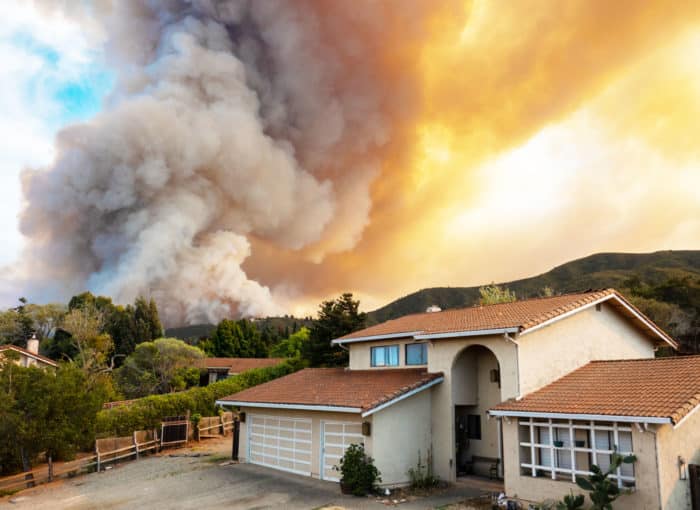
Reduction of Fire Protection
A 7/8 thick Traditional Hard Coat stucco is generally considered a non-combustible siding. For example, the California Building Code considers a 7/8 inch thick Traditional hard coat stucco wall to be noncombustible, based on its ability to pass standard fire testing protocols. If the stucco is not as thick as it should be, then there is a reduction in its resistance to fires, which becomes critical when the home is of wood frame construction.
Stucco that is too thick or too thin may cause lathing problems
Overly thick stucco may weigh so much that it causes the wire or metal lath to sag in places. It may be so heavy that over time it pulls the lathing completely loose from the studs or substrate; the stucco may bow or hunks of stucco may fall off due to the extra weight. This is especially a concern if the lathing was not properly installed or well secured. Occasionally, if the stucco was applied too thin, then part of the lathing may shadow or show through, and cracks might appear where there was insufficient stucco covering over the lath.

Stucco which is too thin or too thick may cause a number of problems for a homeowner. Since it is exceedingly difficult to tell how thick stucco is for most people without having a professional do forensic testing, it is wise to examine your stucco for warning signs of problems and based on your examination, decide what steps you should take if any.
If there are cracks, bulging walls, flaking or other damage, then repair and maintenance is wise. Catching problems early can be much easier to repair, than waiting until later when significant damage and cost may be incurred. In some cases where an insurance claim is made after you discovered significant damage, it may be denied for failure to have done proper maintenance to prevent severe damage.
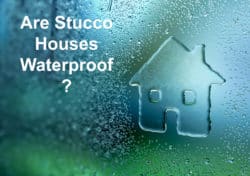
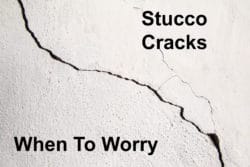
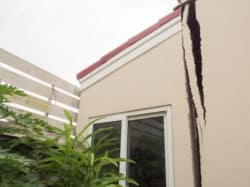

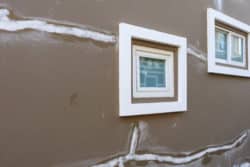



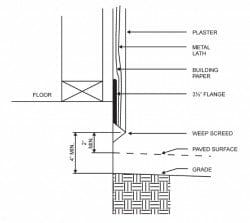

Portland cement stucco/plaster, when applied directly on concrete masonry, offers a robust 12-inch thick face that is integrally linked to the masonry substrate. When three coatings of plaster are placed on a metal lath, the total thickness is 7/8-inch.